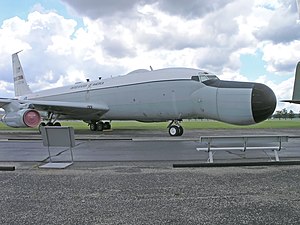Boeing EC-135
| Boeing EC-135 | |
|---|---|
 |
|
| EC-135E nicknamed "Bird of Prey" at the National Museum of the United States Air Force | |
| Role | Tracking and Telemetry Platform |
| Manufacturer | Boeing |
| Introduction | 1968 |
| Retired | 2000 |
| Primary user | United States Air Force |
| Developed from | C-135 Stratolifter |
The Boeing EC-135 was a command and control version of the Boeing C-135 Stratolifter. Modified for the Operation Looking Glass mission, during the Cold War, EC-135 were airborne 24 hours a day to serve as flying command platforms for the military in the event of nuclear war. The EC-135N variant served as a tracking aircraft for the Apollo program.
The Advanced Range Instrumentation Aircraft are EC-135Bs, modified C-135B cargo aircraft and EC-18B (former American Airlines 707-320) passenger aircraft that provided tracking and telemetry information to support the US space program in the late 1960s and early 1970s.
During the early 1960s, NASA and the Department of Defense (DoD) needed a very mobile tracking and telemetry platform to support the Apollo space program and other unmanned space flight operations. In a joint project, NASA and the DoD contracted with the McDonnell Douglas and the Bendix Corporations to modify eight Boeing C-135 Stratolifter cargo aircraft into EC-135N Apollo / Range Instrumentation Aircraft (A/RIA). Equipped with a steerable seven-foot antenna dish in its distinctive "Droop Snoot" or "Snoopy Nose", the EC-135N A/RIA became operational in January 1968, and was often known as the "Jimmy Durante" of the Air Force. The Air Force Eastern Test Range (AFETR) at Patrick AFB, Florida, maintained and operated the A/RIA until the end of the Apollo program in 1972, when the USAF renamed it the Advanced Range Instrumentation Aircraft (ARIA).
...
Wikipedia
